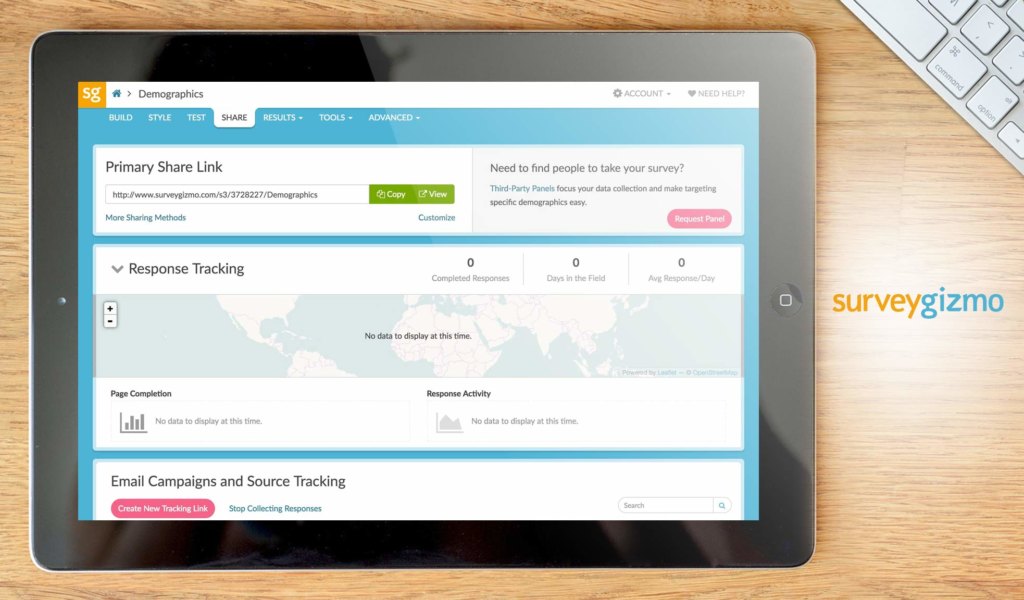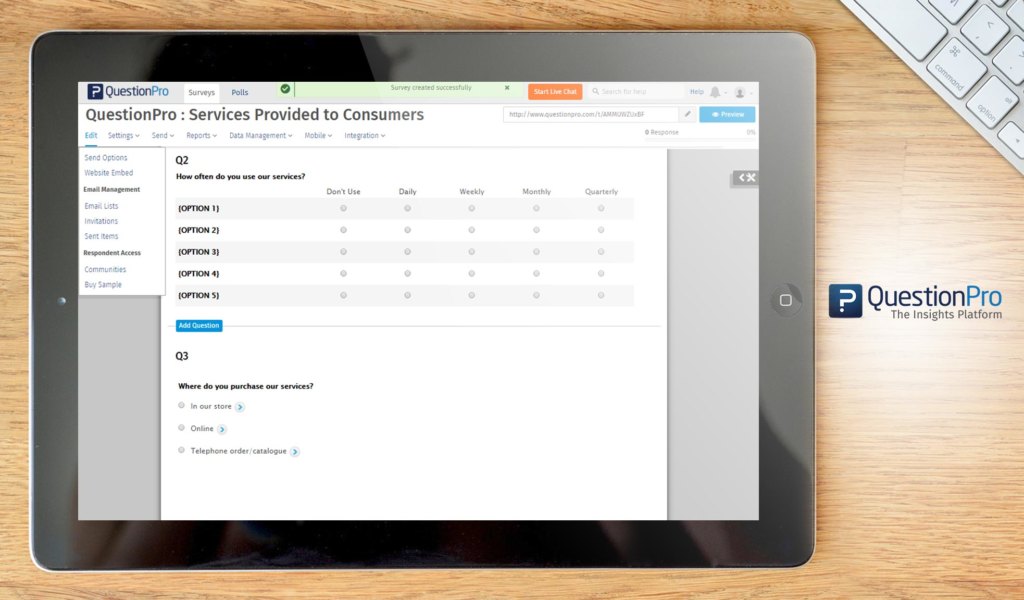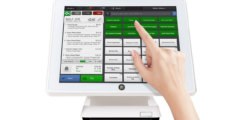Survey software is an application used to collect feedback from a targeted sample through a computer-assisted method, which comes in different ways. At its core survey software solutions help you design, send and analyze surveys, usually via the internet and using drag-and-drop tools and automated functionality. Survey software solutions make the entire process faster, more accurate and easier to accomplish than manual surveys.
It can be used in a variety of ways, such as for customer feedback, employee satisfaction, post-event analysis, market research and academic program assessment. Generally, survey software helps you with the following: ask the right questions; reach your audience; analyze feedback; and take action on the insight.
In this guide, we’ll give you a detailed explanation of the software category beyond answering, What is survey software? Specifically, we’ll walk you through the definition of the following main points:

Guide to Survey Software Table of Contents
Growth of Survey Software
The growth of online surveys and its enabler, survey software, can be tied to ecommerce, which in itself is experiencing a rapid growth. Technavio reported that the global online survey software market will continue to experience a 12% CAGR until the end of 2021, within the same period that ecommerce transactions will plateau. The software category will, however, break down into niches, targeting verticals such as healthcare, market research, retail, financial services and manufacturing.
Likewise, mobile usage enables survey designers to laser target respondents, further enhancing the appeal of survey software. This is because it allows for location-targeted campaigns that increase a company’s understanding of their clientele. The ability to locate respondents is also being used in survey projects and the same growth trajectory is expected in this niche as more people consume internet content from their phone or tablet.
Source: Research and Markets & Business Wire
Examples of Survey Software
Survey software solutions come in different feature sets, pricing and capabilities. Let’s take a look at some of the examples of survey software to give you a clearer picture.
Qualtrics
Qualtrics Research Core is an experience management platform ideal for collecting and analyzing customer and employee feedback. The CoreXM solution includes the survey tool, reporting & dashboards, market research and pricing analysis.
QuestionPro
QuestionPro suits small and medium businesses that need to launch a web-based survey fast and easy. It features multiple templates including thirty question types and twenty professionally designed themes. Results and reports can be exported to csv and other file formats.
Sogolytics
Sogolytics, formerly known as SoGoSurvey, is an enterprise online survey software with an advanced data management feature. The software consists of, among others, a core survey platform, an employee experience feature and assessment tools that help you measure feedback. Sogolytics can automate processes, route tickets and trigger alerts.
SurveyMonkey
SurveyMonkey is a SaaS survey solution that allows for different types of survey projects, including market research, poll, comparative analyses and employee feedback. The app comes with a freemium for freelancers and small business; it also includes enterprise features like skip logic, phone support, unlimited questions and responses and advanced survey logic.
SurveyGizmo
SurveyGizmo (now Alchemer) comes with a free app and suits small business to large enterprise survey projects like polls, quizzes and questionnaires. The app allows for interactive experience using pipe data, charts, loop pages and other advanced options.
Cofirmit
Confirmit is one of the more sophisticated survey platforms in the market. It lets you author a survey and deploy it through various modes like web, CAPI, phone, paper and mobile. Likewise, it has the standard tools of a good web-based survey solution, such as survey designer, panel management and analytics.
ProProfs
ProProfs Survey Maker is a powerful and easy to use online survey solution designed for educators, marketers, event planners, and organizations. Built with a drag and drop user interface and mobile-friendly features, the survey tool is used for collecting customer feedback, conducting market research and demographic analysis, evaluating course effectiveness, and other goals or activities.

Benefits of Survey Software
Why use survey software? There are plenty of benefits of survey software and that depends on the feature set. Generally, you should experience the following advantages and you’ll realize the critical purpose of survey software to your business.
- Design surveys like a pro. Advanced survey software solutions feature predictive analytics that can calculate how well your survey will fare. Various metrics are analyzed including the length of the questionnaire, its relevance to your audience and your historical survey results. The more established solutions with years of handling survey processing can also provide a knowledge base of best practices in the trade. Likewise, many solutions allow the interface to be white labeled. You can lend to the UI your logo and colors and create a personalized thank-you page with your key messaging.
- Reduced costs. If you conduct online surveys via software you bypass labor and material costs. Manual surveys involve time and money for printing, distribution and data collection. Huge surveys will especially benefit from using software-based surveys, as questionnaires can be replicated and distributed repeatedly with little cost and only require a small team to manage.
- Centralized data gathering. Survey software also makes data collection more systematic by saving all feedback in one database. The process is in real-time, as soon as respondents provide the answers the information is saved in a server location. Hence, there’s less risk of losing or tainting raw data and the process is a lot easier and faster than manual surveys.
- Flexible. You can change parts of or the whole questionnaire with minimal cost or repurpose the same questions to target a new set of audience. Survey software allows you to optimize your surveys in many ways.
- Reach your audience. Many solutions also offer a network of respondents by a variety of categories, such as demographics, industry, profession and interest. If you lack for a ready pool of respondents, this service is a great way to jumpstart your survey, mainly via online. Your survey is sent via email, web or social depending on the application.
- Extract insights. Having a wider audience reach and with the data centralized, survey software solutions can conveniently run analytics and help you extract feedback insights. Most solutions allow for various ways to slice and dice data in tables, charts or graphs. Some solutions even feature real-time analytics so you get the freshest results possible.
- Respondent-friendly. Many people are comfortable answering questions in their private digital space or finish the questionnaire at their own pace while connected to the internet. Respondents are also more open to their real thoughts or feelings under the cloak of anonymity, which bodes well to the integrity of feedback that you want.
- Researcher-friendly. Questionnaires are easy and fast to design and distribute, while feedback can come in in real time. Plus, analytics can extract insights from the most complex combination of datasets; hence, survey software makes life easier for researchers.
Types of Survey Software
What does survey software do? It depends on the type. Survey software solutions can generally be divided into different system-assisted methods. Below you’ll find a more detailed breakdown of each type. Note that a solution can be classified under all types or a couple or just one depending on its modules. Likewise, survey software can either be SaaS (cloud hosted) or on-premise (locally installed).
- CATI. Computer-assisted telephone interviewing uses telephony as the main channel to conduct the interview. A software application provides a structured questionnaire, a phone system and the contact information of respondents. Phone calls are coursed through the system. A critical CATI feature is a built-in logic that skips questions that are irrelevant to respondent and its ability to automatically consolidate answers to churn out statistics.
Example: WinCati - CAPI. Computer-assisted personal interviewing is similar to CATI except that the interview is done in person. CAPI is ideal for long, complex questionnaires. In this setting, the software may provide an interface for both interviewer and interviewee, so both parties use separate computers to manage the questions and give the answers, respectively. CAPI is used in trade shows and retail, usually in malls where there’s a captured walk-in audience.
Example: Surveybe - CAWI. Computer-assisted web interviewing is similar to CATI and CAPI except that the medium is a web interface. A software solution provides the questionnaire, which can be customized or comes in different templates aided by check boxes, pull-down menus and help screens. The main advantage of CAWI is in scalability and coverage; it can accommodate respondents simultaneously and anywhere there’s internet. The disadvantage is that feedback is less accurate and may even be prone to spamming. For the most part, we’re discussing survey software as a CAWI type, which may or may not come with CAPI and CATI features.
Example: IdSurvey
Features of Survey Software
How does survey software work? Different solutions allow you to set the survey process and dynamics in different ways and may include all or some of these features. Here are the expected features of survey software:
- Survey builder. Typical survey builders use a drag-and-drop interface and tools for, among others, layout and design, versioning, question morphing and preview. The builder creates the front-end look and function of the survey, but it relies on another feature, conditions, to set how the survey behaves. For conditions, you have two perspectives: questions and answers.
- Question conditions. Designing a survey requires conditions for both questions and answers. Question conditions may include tools to format style, randomize questions or generate x/y choices. A solution may also feature a timer and allow images and videos for interactive questionnaires. A question library may also be available that lets you archive reusable questions.
- Answer conditions. On the answer side, survey software solutions may offer piping or looping dynamics, option to show/hide questions or randomize choices. Answers can also be preset with conditional triggers that personalize the survey. A good solution may provide custom scripting that lets you create specific unique process flows and behavior.
- Scoring. Whatever answer-question conditions are used, survey software has a scoring algorithm set either as default or based on rules. Scoring and tallying are automated, which speeds up the process of aggregating feedback and generating insights.
- Survey templates. Most solutions provide templates to help kickstart your survey. Templates often accommodate standard questionnaires like leading questions, dichotomous questions, bipolar questions and rating scale types. Polls and forms are also common templates, while some solutions also offer mobile themes.
- Email invitation. A survey solution may include a mailer to send an invite to the questionnaire or it integrates with a third-party app to accomplish this task. A mailer usually includes test responses, which help you fine-tune the questions.
- Multimedia. A survey software solution may allow the use of images, videos and graphics for interactive questionnaires. This functionality can be built-in or as an integrated feature with another app.
- Response management. Data collection can be set in many ways, for example, applying a quota to manage the number of responses, automatically categorize responses and triggering succeeding actions. The feature also allows for tracking multiple iterations and collect feedback in real time.
- Data analysis. This feature varies in sophistication between low-cost and premium plans. Standard analytics show basic summaries, while more advanced solutions may perform cross-tabulation, filtering, weighting and other multivariate statistical methods.
- White label. A survey software solution may let you configure the interface with your brand logo and colors to give your surveys a more professional and appealing look.
- Multilingual support. You’ll find solutions that host different languages, which is useful for conducting surveys in different global market territories. The feature may include a spell-checker for each language and an auto-detect or opt-in tool that set the questionnaire to the default language of the respondent.

Buying Factors to Consider
When getting a survey software vendor make sure the features and terms match your requirements and capability, respectively. Below are some of the key things to consider before you subscribe to a plan.
- Multi-mode capabilities. Online surveys give you more efficiency, but it doesn’t mean you ditch the pen, paper and phone. They still have a few advantages over online surveys, mainly, the interaction is face to face so respondents are more committed to giving proper answers. In such case, make sure your survey software of choice can adapt to these survey channels should you deem pen and paper, for instance, is more appropriate for a small sample. Not only that, analytics should accept manual entries so you can feed data into the system from various sources.
- Routing and skip logic. Different survey software solutions have different skip logic capabilities. Skip logic allows respondents to follow different paths in a survey based on conditions. You choice of solution will depend on how sophisticated the feature you want. Generally, there are three types of skip logic: question, page and advanced branching. Question lets you skip succeeding questions based on the previous answer. Page works in the same way but applies to whole pages, while branching acts like page with more variables, including configuring paths based on custom data. If you have varied survey projects, it’s best to have a solution that’s capable of all three skip logic types.
- Randomization. Make sure the software has the capability to randomize questions and questionnaires to avoid biased answers. This feature makes your survey unpredictable by shuffling the question order or altogether replacing a set of questions with another.
- Design flexibility. A good survey software lets you design the survey in different ways. These can be: based on structure (single or multiple responses, write-in response and rating); survey path (various skip logic types); and mode (printed, online or hybrid). Similarly, it can be automated and allows manual intervention when necessary. Finally, it should be customizable to your branding elements.
- Sampling. Not all solutions provide a sample of your targeted respondents. It may have added cost, but a sample lets you fine tune your survey before its full-scale launching, so you avoid costly mistakes. Also check how much the sample being offered by the vendor can be sorted to match your target audience.
- Scoring types. Survey software should go beyond aggregating Y/N answers. Scoring should be flexible to help you slice and dice feedback in many ways. A good solution allows you to construct executive summaries on your select metrics. Likewise, it can facilitate top-box scoring, mean scoring and mixed-mode results, handle cumulative feedback frequency and, generally, can interpret complex statistical data. Visual presentations a big plus to help your different audiences quickly grasp insights with clarity.
- Automation. Different solutions vary in their level of automation. Again, how sophisticated you want automation to be will depend on your choice of feature set. Of course expect to shell out more for advanced solutions. Generally, automation should be present in designing the survey, distributing it and collecting data. By automating these three time-consuming aspects of the survey, you can focus on planning and interpreting the survey and its results, respectively.
Pricing of Survey Software
Survey software price plans come in a variety of ways. Generally, pricing can be a freemium and separate packages for small business and enterprise. Here are the typical cost of survey software:
- SurveyMonkey. Many top survey software solutions offer plans for small, medium and large businesses. On top of the paid plans, there’s a free version for freelancers or small projects. SurveyMonkey is one example, with its paid plan starting at $25 per month.
- ConfirmIt. Some vendors like ConfirmIt only entertain a pricing quote instead of offering fixed paid plans. The quote lets them customize the feature set based on your specific requirements.
- Qualtrics. Some quote-based pricing are also only available through an annual subscription like with Qualtrics. This plan suits a company that conducts regular survey projects, where an annual subscription can give them deals and discounts.
- QuestionPro. Packages are usually grouped by feature set; the more advanced the features the higher the price. For example, QuestionPro only offers custom theme, brand and URL in its Corporate Plan at $99 per month.
- SurveyGizmo. Some solutions offer a free app that is surprisingly rich. For example, SurveyGizmo provides unlimited surveys, unlimited questions and unlimited responses. This gives you a lot of flexibility to design your survey at no cost. The solution also offers paid plans starting at $25 per month.
Potential Issues
Survey software has its set of issues and problems, but none that cannot be addressed with the right context. Below are the common issues faced by first-time users of these solutions.
- Privacy. It’s not just an issue with survey solutions, but mainly the entire SaaS industry. An online survey app will get hold of your list; no matter how transparent the terms and disclaimers of the vendor, the fact is you’ve given away your list by uploading it into the system. Even if you don’t have a list to start with, building one that is shared with a third party, the vendor, can be at best an annoying aspect of cloud solutions. However, the advantages of survey software easily outweigh the privacy issue.
- Survey fatigue. What is survey software but to make survey projects easy to create and launch at a low cost? The downside is, everybody can do surveys, which leads to saturation of the respondent pool or oversampling and low response rates. Just how many surveys do you encounter in one internet browsing period and how many of these questionnaires you’ve given attention, really? In this context, pen-and-paper and phone interviews may provide a good alternative to grab respondent’s attention.
- Relying on templates. Templates are supposed to guide you or fast track your survey design. It should not replace the design process itself. In short, a template should fit your design and not the other way around. That’s why most solutions let you tweak the template to fine tune it along your design structure. If you depend on template to design your questionnaire, you may be compromising the integrity of feedback.
- Budget is pulled down. Because many online survey solutions are available at low cost, even free, management may be hesitant to put more budget into your survey. This shift in mindset looks at surveys as a function of software and not a professional discipline that requires investment to guarantee data integrity.
- Everybody is an expert. To the chagrin of statisticians, armchair surveys are being used for strategic planning, thanks to the ease in using and low-cost of survey solutions. A wrong interpolation can prove catastrophic to the company’s long-term survival. Software is only a tool and should not replace the discipline and knowledge of a statistician or researcher to design and interpret surveys.
Latest Trends
The future of survey software will depend on changing respondent behavior, user behavior and advances in technology. Take a look at some of these trends in the coming years.
- Democratizaton of surveys. Low-cost online survey apps and the availability of online respondents make it possible for small business and freelancers to run their own surveys. As survey projects proliferate, so does the quality is expected to suffer. Overall, the very same apps that make it possible to conduct survey will make getting accurate feedback hard to come by as respondents suffer from survey fatigue. The need for restraint and investment in quality, not quantity, surveys is more than ever necessary.
- Multichannel options. Surveys have to adapt to respondents’ preferences and they vary. Some will answer questions on the web, while other from their phone. Others may ignore online forms but will welcome a phone interview. To cater to the ever-increasing choices of respondents, there are solutions now that allow them to choose the survey’s medium.
- Artificial intelligence. AI impacts on almost all technology markets including survey software. Machine learning is now being tested on formulating questions that adapt to specific sample sets, allowing designers to target more respondent groups with increased frequency.




























Leave a comment!